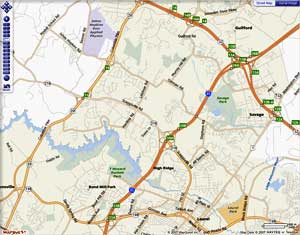Specifications Overview ![]() Image Galleries
Image Galleries ![]() Funding
Funding ![]()
![]()
![]()
![]()
![]()
![]() Dome Specs/Plans
Dome Specs/Plans ![]()
|
THE "MCCM" ASTRONOMICAL OBSERVATORY
There was an unusually good omen for the new observatory. As the date of the ribbon-cutting approached the days were more and more cloudy until on the day of the event the coverage of clouds was complete from horizon to horizon. When the event commenced at 7 pm the skies were still completely cloudy. At 8:38 pm, as the ribbon was cut opening the observatory dome, someone called out "a star!". We looked to up see a small area of cloud cover had thinned just enough to reveal Jupiter, but no other stars or Moon across the sky could be seen. We powered up the telescope and its control systems, opened the dome, then turned the telescope onto the giant planet - now about 49 Arc. Secs. in diameter and about as well positioned as it gets for us to view from Earth. Although the facility had only one eyepiece, a TeleVue 41mm Panoptic providing only a modest 119x, over the next twenty minutes or more Jupiter put on a great show for those who walked up the steps to the eyepiece of the telescope and enjoy that sight. Simply amazing good luck!
The facility has been relocated from the clear and dark skies of Arizona to the light polluted skies of Maryland where it and its associated equipment with other visual and radio telescopes will hopefully be made available for the following purposes:
This facility will as a matter of principle and practice not compete with but will work to promote the regional non-profit astronomical societies as Company Seven has historically done.
M. Cohen, Field Marshal General and Beneficent Dictator For Life Timeline - Briefy: The owners of the land in Arizona where the observatory was installed planned alternative uses for the property, and so we removed the Observatory in June 2008 to storage while a suitable site was contemplated. The crated telescope and structures were stored in Laurel, Maryland until a site was readied for them. In order to fund locating the observatory onto land that would be accessible by the public we initially invited donations while we also considered some cooperative relationship with local government and educational organizations.
|
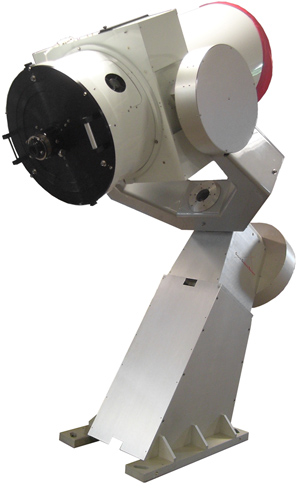 |
|
 Biosphere 2: The Vision & Columbia University
Biosphere 2: The Vision & Columbia University

Above: Biosphere 2 campus center.
 Biosphere 2 Observatory: Concept and Construction
Biosphere 2 Observatory: Concept and Construction
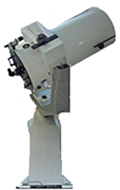 By 1998 Biosphere 2 was then a part of the Columbia Earth Institute, a consortium of more than a dozen research and education resources dedicated to studying the Earth and the environment. The astronomical observatory was conceived in 1998 as strictly a Columbia University initiative that was to be operated by them and with some interest from University of Arizona. It was envisioned to compliment the ongoing Earth Science programs at the campus by participating in Near Earth Asteroid (NEA) objects sky surveys and to support educational outreach programs.
By 1998 Biosphere 2 was then a part of the Columbia Earth Institute, a consortium of more than a dozen research and education resources dedicated to studying the Earth and the environment. The astronomical observatory was conceived in 1998 as strictly a Columbia University initiative that was to be operated by them and with some interest from University of Arizona. It was envisioned to compliment the ongoing Earth Science programs at the campus by participating in Near Earth Asteroid (NEA) objects sky surveys and to support educational outreach programs.
The observatory complex design was finalized in early 1999 by Gresham & Beach Architects, Inc. an accomplished firm in Tucson, Arizona. In keeping with the Bass tradition of doing things beyond well, the facilities incorporated several advanced environmental features in its design and construction. The benefits of professional design include the incorporation of numerous features that make this facility versatile and highly reliable, with aesthetics that inspired confidence and were pleasing to the eye.
The observatory was situated on a bluff high above and to the east of the Biosphere 2 center. When the telescope was installed one could see few signs of civilization in the Oro Valley to the south, but by the time the telescope was relocated in 2008 one could drive from the observatory to a "Home Depot" store in about 20 minutes.
The facility consisted of the telescope housed in a first class 5 meter diameter dome made by Ash Manufacturing, atop its support structure of welded steel, and with a classroom and control center building and public viewing area nearby.
Fabrication of the 24 inch (0.61m) telescope and its optics, and of the observatory dome and related structures were afforded the appropriate care and diligence since this was hoped to become a jewel in the public eye. The contract to construct the telescope optical tube, mount and its control system was awarded based foremost on merit and competence to 'Optical Guidance Systems' (OGS) of Huntingdon Valley, PA. It is good to have the means to build things well! This Ritchey-Chrétien telescope was popularized correctly as being similar in design to the Hubble Space Telescope. The telescope is computer-controlled either locally or the entire observatory can also be operated remotely via the Internet. So observers worldwide were able to log on to the Biosphere 2 Web site to view southern Arizona's night skies.
The Observatory was constructed over the summer, the telescope installed, and the facility dedicated at 11 am on 11 October 1999 along with a new Student Center housing the Student Union, a computer lab and study area, workout facility, and health services office. The event was attended by Arizona Congressman Jim Kolbe, Edward Bass, Columbia University President Dr. George Rupp, President Winifred Warden of the Bert W. Martin Foundation, and Biosphere 2 President and Executive Director Dr. William Harris.
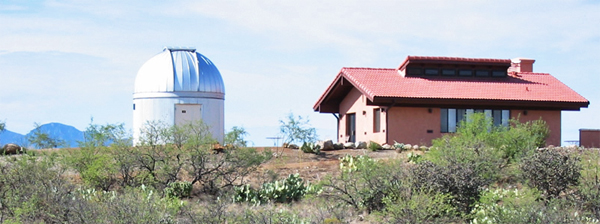
Above: Biosphere 2 Observatory and the Control Center/Classroom Building. Click on image to see enlarged view.
 While in service at Biosphere 2 the Observatory provided the public, High School and College students the opportunity to learn about astronomy, to study variable stars, supernovae and near-Earth asteroids. It offered short courses on astronomy open to the public, and the Passport to Learning program that introduces school-age children to the wonders of their Earth.
While in service at Biosphere 2 the Observatory provided the public, High School and College students the opportunity to learn about astronomy, to study variable stars, supernovae and near-Earth asteroids. It offered short courses on astronomy open to the public, and the Passport to Learning program that introduces school-age children to the wonders of their Earth.
Right: Biosphere 2 logo; what a magnificent concept in environmental stewardship this has been!
"It will provide Universe Semester students with a world-class chance to study astronomy and provide a new resource for Tucsonians and visitors," announced Chris Bannon, Vice President for operations at Biosphere 2. "This observatory is part of Columbia University's master plan to develop new education and research assets for our faculty and students," said Dr. William Harris, president of Biosphere 2 Center. "The new telescope will complement the larger telescopes Columbia astronomers use at the Kitt Peak Observatory." The facility hosted among others the Universe Semester program, an intensive semester-long undergraduate program in astronomy and astrophysics in which students could enroll for up to 16 credit hours of Columbia University astronomy classes. The curriculum was designed both for astronomy majors and for adventurous liberal-arts majors. These sessions focused on observational astronomy under the clear desert sky, miles away from any significant light pollution from the cities. Courses taught included introductory solar system or galactic/extragalactic astronomy, sophomore level classes in both stellar and galactic astrophysics, an upper level class in planetary atmospheres and one physics class each semester. Extensive research programs were carried out in astrometry and photometry of asteroids, and photometry of cataclysmic variable stars too. For this the 24 inch telescope was furnished with an Apogee CCD camera, a spectrograph, and numerous smaller portable telescopes complimented the programs. People from Columbia University who were directly involved included Dr. Joe Patterson and Dr. Karen M. Vanlandingham (the original instructors of the program), instructor Katy Garmany, and Eve M. LoCastro.
Another program conducted at the Biosphere 2 Observatory was Summer of Stars, a four-week summer program offering college students the opportunity to study the planets, moon, Comets, stellar formations, asteroids, and galaxies using the 24-inch telescope and astronomical CCD camera. The observatory also offered short courses on astronomy open to the public and the Passport to Learning
 Near Earth Objects - Dynamic Site Project (NEODyS)
Near Earth Objects - Dynamic Site Project (NEODyS)
 The Biosphere 2 Observatory participated in the international Near Earth Objects - Dynamic Site (NEODyS) project where data about near Earth objects are collected and analyzed to calculate Earth Impact Possibilities and to provide risk assessments. The NEODyS web site at http://newton.dm.unipi.it/neodys/ hosts observational data contributed from more than 1,340 observatories located around the world pertaining to asteroids, comets, and other moving objects within our solar system. The data is continually and (almost) automatically maintained database of near Earth asteroid orbits, while Comet orbit data are planned to be added in a future expansion of the mission.
The Biosphere 2 Observatory participated in the international Near Earth Objects - Dynamic Site (NEODyS) project where data about near Earth objects are collected and analyzed to calculate Earth Impact Possibilities and to provide risk assessments. The NEODyS web site at http://newton.dm.unipi.it/neodys/ hosts observational data contributed from more than 1,340 observatories located around the world pertaining to asteroids, comets, and other moving objects within our solar system. The data is continually and (almost) automatically maintained database of near Earth asteroid orbits, while Comet orbit data are planned to be added in a future expansion of the mission.
This site provides a number of services to the NEO community:
- For each NEO in the NEODyS database the results of their orbit determination are available for inspection and comparison with other sources. Everything needed by the user to verify the computations is available online, including software for a variety of operating systems.
- The NEODyS observation prediction service provides ephemeris predictions and finder charts with information on the linear or semi-linear confidence region as appropriate. An online document describing the semi-linear confidence theory is available.
- Each object is linked to a database of known physical properties.
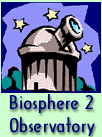 The Biosphere 2 Observatory was designated NEODyS Observatory No. 853. Between 12 October 1999 through 29 November 2000 the Biosphere 2 Observatory telescope contributed 449 observations of Near Earth Asteroids (NEA) to the NEODyS program. The information provided by the Biosphere 2 Observatory to NEODyS were recorded and made available to researchers and to the public at http://newton.dm.unipi.it/neodys/index.php?pc=2.1.0&o=853. We have preserved the data pages intact, and make them available here:
The Biosphere 2 Observatory was designated NEODyS Observatory No. 853. Between 12 October 1999 through 29 November 2000 the Biosphere 2 Observatory telescope contributed 449 observations of Near Earth Asteroids (NEA) to the NEODyS program. The information provided by the Biosphere 2 Observatory to NEODyS were recorded and made available to researchers and to the public at http://newton.dm.unipi.it/neodys/index.php?pc=2.1.0&o=853. We have preserved the data pages intact, and make them available here:
- 853 - Biosphere 2 Observatory - Observations, Page 1
- 853 - Biosphere 2 Observatory - Observations, Page 2
* Magnitude is a measure of how bright or faint an object is. The lower the number, even into negative numbers, then the brighter the object is. The measure of magnitudes is not a simple progression but it is instead a logarithmic scale, so that for example a magnitude number change from 1 to 2 is a step 2.512 times fainter. A star that is two magnitudes fainter would be 2.512 x 2.512 or appear 6.31 times fainter. A five fold magnitude change would differ by a factor of about 100 times. The healthy human eye at night can see objects as faint as about 5.5 to 6. This 24 inch telescope should under ideal skies show objects to the eye as faint as about magnitude 16. Using 1990's CCD camera technology it showed objects to magnitude 20.3.
 The End of Columbia U Cooperation & Operations
The End of Columbia U Cooperation & Operations
In January 2003 Columbia University's new president, Lee Carroll Bollinger (a lawyer and educator) announced that the University was "reviewing" its relationship with Biosphere 2. This led to a law suit which was settled and mid December 2003 the Columbia University announced it was pulling out of its original agreement to operate Biosphere 2 through 2010. This uprooted some 150 scientists and educators who ran its affiliated programs, and left many of them bitter against Columbia University for what they described as mismanagement of the operation business plan. The observatory essentially became mothballed with the arid environment and protective dome preserving the telescope and other instruments associated with the original effort. Encroachment from the growing nearby communities not only meant the quality of the night skies were diminishing, but also the value of the land was deemed to exceed the scientific value of the programs.
On 4 June 2007 the Biosphere 2 and surrounding land totaling some 1,658 acres was sold for $50 million to CDO (Cañada Del Oro) Ranching & Development, L.P. The core 34 acre complex including the Biosphere 2 with the magnificent structures shown above were donated to the University of Arizona, and this will remain operating for research and education purposes for the foreseeable future. As the remaining acres of project are planned for redevelopment into housing and other uses, the decision was made to dispense with the Observatory.
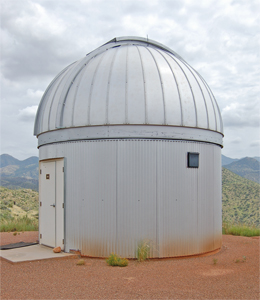 Biosphere 2 Observatory Ash Manufacturing 5 meter Dia. Dome Exterior showing the entrance |
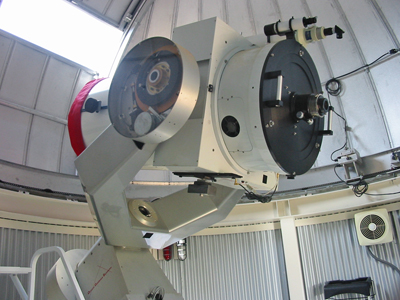 OGS 24 inch / 0.61 meter Ritchey-Chrétien Telescope left rear view note dome shutter partially open |
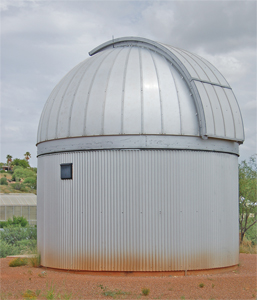 Biosphere 2 Observatory Exterior reverse angle from prior view |
Table Above: Observatory and telescope as it appeared while at the Biosphere 2 complex in Arizona in May 2008.
Click on each image to see the enlarged view.
 The Acquisition and Removal from Arizona
The Acquisition and Removal from Arizona
On 9 August 2007 the Biosphere 2 Observatory was acquired from CDO Ranching and Development by the owner of Company Seven. When the decision was originally made to acquire the Observatory and to relocate it to Maryland it was conceived to become his private observatory. But after considering the advanced capabilities of this modern observatory system, and the lack of access by primary and secondary school children to such resources, the choice was made to consider establishing this in a manner that would make it convenient for educators and their students. Over the week of 22 June 2008 the Observatory Telescope, Dome, and welded steel Base were disassembled. The telescope and dome were crated and removed to Maryland. The Base will follow in a separate shipment. Plans call for the establishing this as the core of a science center focused on education through astronomy cooperating with other programs which Company Seven has assisted in the region.
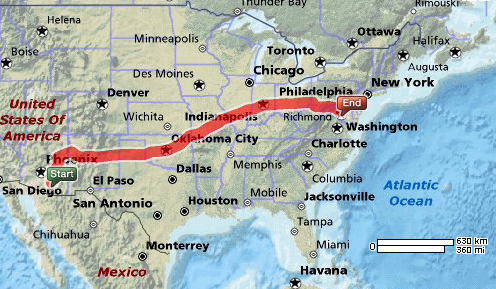
Above: The course to relocate the Observatory from Arizona to Maryland was a 2,400 mile venture!
Disassembly of the facility in Arizona commenced on the afternoon of 22 June 2008. We rented a 26 foot Penske truck with liftgate, and filled it up earlier than planned. The truck was on the road leaving Biosphere 2 by about 4:30 pm on Wednesday 25 June. All items were crated and packed with the exception of the welded Base, that was quartered and was prepared for delivery later by a tractor-trailer. The truck traveled some 2,380 miles over about 2-½ days in transit; this included brief motel stays in Amarillo, Texas arriving after midnight on 26 June, and in St. Louis, Missouri arriving early in the morning of 27 June. The shipment arrived in Laurel, Maryland by about 5:00 am on Saturday 28 June. For those who are curious, our cost to rent the truck in Tucson with unlimited mileage and drop-off in Maryland was about $835, the 284 gallons of diesel fuel cost $1,314. The total costs paid for the disassembly, crane/rigging, crating, and transport of the telescope and dome to Maryland amounted to approximately $23,300. The steel base section would be stored near Tucson then called for later, and those costs billed separately. Some of the less experienced among us were beginning to understand how the costs of even moving such large telescopes can be notable!
Warehouse space in the City of Laurel, Maryland had been offered by a benefactor for the temporary storage of the observatory components until a suitable location can be purchased or leased. So on 30 June 2008 the Telescope, Dome and accessories were moved into storage in Laurel, Maryland.
Mr. Jim Gresham, the architect whose firm designed the Observatory complex, provided copies of the original blueprints of the observatory facility to the MCCMO team. So we can not only quickly contract for the fabrication of the observatory concrete foundation and utilities, but we might also recreate the nearby classroom and control structure possibly with some modifications to suit our colder climate.
 On 16 and 17 March 2009 the complete crated telescope with its pier was picked up at our Laurel warehouse then sent by truck to the OGS facilities in Pennsylvania. OGS built this telescope so they were assigned the task of bringing if out of 'mothballs' storage.
On 16 and 17 March 2009 the complete crated telescope with its pier was picked up at our Laurel warehouse then sent by truck to the OGS facilities in Pennsylvania. OGS built this telescope so they were assigned the task of bringing if out of 'mothballs' storage.
Right: our OGS telescope on static display at NEAF in New York. Image © David Illig, used by permission (80,957 bytes).
Click on image to see enlarged view (234,860 bytes).
Our "eye-catching equatorial-mounted 24-inch Ritchey-Chrétien by Optical Guidance Systems" has been featured in several on-line news postings about the event. And this was followed by a full page photo in the coverage by Sky & Telescope magazine.
After the NEAF event the telescope was returned to the OGS shop in Pennsylvannia to continue preparing it for service. This work in principle includes replacing or updating any aspects of the telescope so that it fully complies with whatever is expected from a research class telescope in 2009: encoding the Worm Gears for closed-loop feedback computer control, updating the COMSOFT control system, setting up the Secondary Mirror Focus Control for remote operation, etc. This also include stripping the original mirror coatings and recoating the mirrors with an even higher transmission coatings group. The mechanical components are being cleaned and lubricated, all the while evaluating the condition of the optics coatings and mechanics and then powering on the updated COMSOFT control system to insure all is there and working properly. The tilt of the telescope's aluminum pier will be modified to suit our local latitude.
Before putting the telescope into service there are a few remaining technical matters, we can complete all within a matter of weeks. At the head of the list are the mirror coatings. Consider that standard telescope mirror coatings typically each reflect 88 to 92 percent of the incoming light so in a two mirror system this results in a cumulative loss of between 15 to 23 percent. Our goal is to loose not more than 8 percent total by removing the original mirror reflective coatings and then applying new technology coatings to both the Primary and Secondary mirrors. This 24 inch telescope should therefore perform should well above what is typical for commercial professional grade telescopes generally made today. In July we began to study and compare technical data that will allow us to make the determination of what optical coatings will serve us best. We are evaluating the risks and costs of ordering coatings for the mirrors that will transmit upper 90 percentile across the visual spectrum.
1. Continuing discussions since January 2009 with George Mason University in Fairfax, Virginia to loan our OGS RC-24 telescope to them while they resolve some difficulties in completing a new 32 inch telescope for their new campus observatory. GMU has constructed a striking observatory building topped with an Ash 6 meter diameter dome (1 meter larger than our own) at their Fairfax campus. However, the bid for the new 32 inch telescope, awarded by GMU in 2006 to ObservatoryScope company (Timothy David Puckett and Michael Marcus) of Georgia, failed to materialize - to put it mildly. Since they have a new observatory with no telescope, and we own a like new telescope with no observatory, then this could be a good interim solution for both of us. In July 2009 Professor Harold Geller of the GMU Physics Department discussed the possibility of the GMU raising the funds needed to modify our 24 inch telescope to suit their purposes and then install it at the University. Some astronomy organizations and individuals in the area have been alerted about this possibility, and some have volunteered to donate money to make this happen.
We do not mind loaning the telescope and feel GMU is better positioned to pay some of their own way on this than we are. If the University can raise the $30,000 or so from private sources then the Administration would certainly be happy to see the telescope placed into service there at GMU! The money will cover costs associated with installing the telescope at GMU (paying OGS for the metal pier modifications to fit the pier at GMU, crane - about $7k!, electricians, transport, staff training, computers and COMSOFT software that will remain at GMU and be used with the coming 32 inch telescope, etc.) and later removing it when the 32 inch comes available. The school gets to use an approx. $240,000 dollar system (as it is equipped) for about the same as it would cost merely to install, setup and later remove. Our most recent proposal to GMU bears an expiration date of 10 October.
2. In October a Government laboratory in this region has inquired about obtaining this telescope for their use. The instrument is required there for research as telescopes proven to have similar capabilities are not readily available on short notice. This organization would be able to employ the telescope Dome and its base structure as well. There have been expressions of interest by the local government in seeing this telescope operating in this county, and so there may be some way in which we may be able to negotiate some opportunities to permit access to the telescope for local primary and secondary schools. We are awaiting the decision by GMU before pursuing this option.
We could have sold this RC-24 telescope several times since it was acquired, but our preference remains to hold onto it and do something good for the kids - to get them off their gaming PC's for at least once so that they can marvel at something far more fascinating: the real Universe.
We have reached an agreement with the Johns Hopkins Applied Physics Laboratory to locate the observatory there in Maryland. The intended mission remains as originally stated: to make this telescope and its observatory structure available periodically for visual astronomy experiences by local elementary and junior high school students. Over the first year of service we do not anticipate hosting students directly at the telescope, though this is the long term plan that may be implemented later in 2012.
The telescope was sent to OGS, the manufacturer of the telescope, to bring the telescope out of mothballs. This work included complete cleaning, lapping and lubricating of the Byer's drive gear sets, cleaning and lubrication of the motors and bearings. Complete upgrading of wiring and changes of length as necessary to work in the new planned location. The Primary and Secondary Mirrors were stripped of their original aluminum reflective coatings, and new state of the art high transmission protected silver coatings were applied to both mirrors. Updating of the computers and control systems so that the telescope will continue to provide a 'state of the art' experience.
Over the Summer of 2010 the final design work was completed to reconstruct the MCCMO dome and base structure, and its foundation at the JHU/APL. The massive concrete foundation work was completed incorporating numerous conduits for signal and power wiring. The Base structure was moved from Arizona storage, precision fit then welded together. The Dome was reassembled with new hardware and rollers, all the weather stripping was replaced. The Base was lifted by crane onto the roof of the prepared platform, then the Dome was installed onto the platform.
The Dome stands at about 500 feet above sea level at a site three stories above local ground level, and with amazing clear views of all the horizons:
Above: The "MCCMO" as it appeared on 17 October 2010, note the Moon coming up to check our our observatory to the left.
On 28 October 2010 the telescope Wedge, Fork Mount, and Optical Tube Assembly were lifted by crane and installed into its Dome at the new location in Maryland. This location, the plans for the use of the telescope, and decisions about access to it are yet to be formally announced.
Later on this day we were treated to a truly beautiful sunset from the Dome. Then after some preliminary connecting of the COMSOFT computer control system and other interfaces by Mr. John Stiles of Optical Guidance Systems (the maker of the telescope) we were treated to a first glimpse of Jupiter high in the southern sky.
Right: The "MCCMO Astronomical Telescope" with the Dome Shutter open undergoing some fine adjustments after installation, anticipating a first look at Jupiter on the evening of 28 October. John Stiles, the owner of Optical Guidance Systems (OGS) who built the telescope, is working on the instrument. The dome has banks of both red and white lighting, but in this photo it is set for red light to minimize adverse effect on night vision. Image © Mr. Noone (130,196 bytes).
But we are not popping the Champagne just yet since work remains to be done including the final collimation of the optics, completing the connectivity of the telescope (electronic Secondary Mirror focuser, etc.), mount, dome and computers for control. The mount is close to Pole Aligned, but this will be refined and the computer models adjusted over several nights to attain the best possible 'go to' pointing and tracking precision. Then we will install two new 70mm telescope finder telescopes (one top and the other accessible from below), along with the Astro-Physics 13cm auxiliary telescope.
Left: the very first snapshot through the reactivated 'MCCMO Telescope' shows the Nectaris region of the Moon on the evening of 11 Nov 2010 (44,962 bytes). This was taken through a hand-held (not too steadily) pocket camera over the eyepiece; note the field stop border of the eyepiece cutting off the Moon at the bottom of the frame. The prominent trio of craters at center are Cryllus, Catharina, and the massive Theophilus; at the eyepieces it's central peak appeared three dimensional as though it were jumping off the Moon at us!
The Moon of course looks amazing, but it looks good in almost any telescope too. But with this 24 inch it certainly seemed to have more of a 3-D quality. When using a a Mirror Diagonal that will erect the image of the Moon so in an eyepiece the orientation appears correct left to right but upside down. So we refer to a "Mirror Reversed" Moon Chart, but turn it upside down to correspond to the view at the eyepiece. We have a Zeiss/Baader Binocular Viewer but that was not used this evening. The Moon was at about first quarter phase and so there were countless details to be observed along the Terminator; one can really appreciate the value of studying the Moon as it progresses through its phases - always something interesting to see!
Later in the evening we turned the telescope onto the Constellation Orion where one can really see how aperture matters. Having 24 inches of telescope, especially one with state of the art hang the expense high transmission silver coatings, shows M42 as an immense and extensive greyish-blue nebula with striking swirling details including streams of deep red (ionized hydrogen) rarely seen from a suburban setting. In fact I had never before seen M42 appear like this from this region; by the time one traveled far enough away from Washington, DC to see deep sky objects well then one tends to be using transportable telescopes that lack the properties of this telescopes. There is no way to convey to others the impact of seeing something like M42 in a telescope without getting them to the eyepiece. No image or CCD camera can do what the human eye can do on bright objects. This image will remain in my mind with a greater impact than if I had just dialed it up on a computer screen or flipped across it in a book. And this has been my point all along: if we wish to truly inspire interest in the sciences, then lets get that next generation to the eyepiece!
Even though the set up of the telescope is not yet fully completed, I congratulated John Stiles, the owner of Optical Guidance Systems for having constructed a fine telescope and Paul Jones (Star Instruments) the maker of the mirrors.
Above: The sky awaits the "MCCM" observatory telescope; as the system appeared near sunset on 11 November 2010. Image by Ed Whitman (234,058 bytes).
So stay tuned for more news about this exciting project!
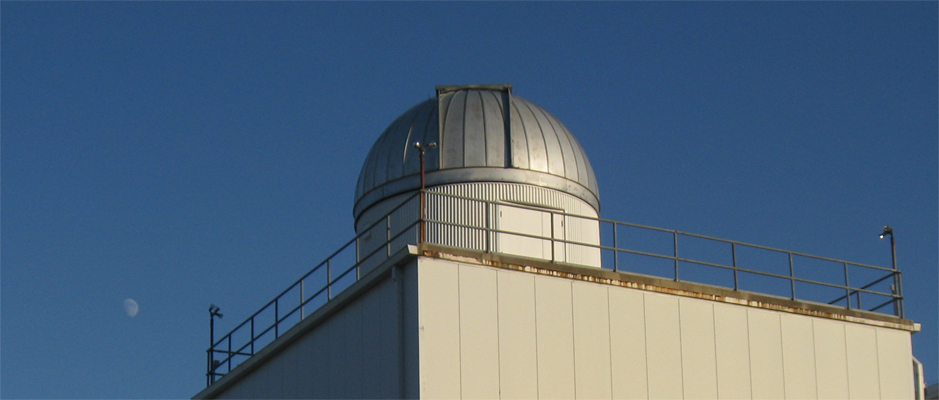
The Dome Shutter is closed, with the Dome rotated so that the Shutter is the opposite side of the Dome and out of view. Image © Mr. Noone (178,434 bytes).
Click on image to see an enlarged view (389,497 bytes).
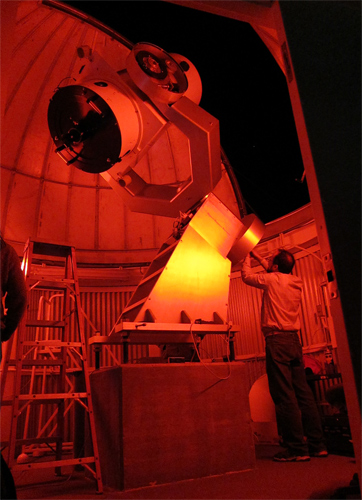
Click on image to see an enlarged view (1,062,475 bytes).
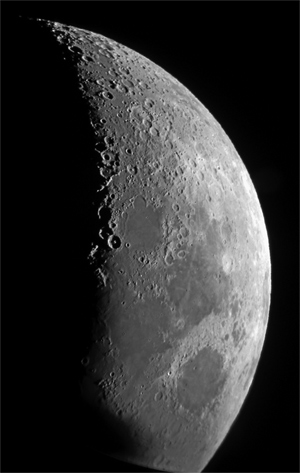 Martin took some photos of these objects with a simple pocket camera merely hand holding the camera over the telescope eyepiece - totally unprofessional and nothing worth printing (yet) but these snapshots captured the moments. Most of the observing this first night was done through a TeleVue 41mm Panoptic, a stunning 2 inch diameter wide angle eyepiece. This eyepiece provides a magnification of about 90x showing an actual field of view of about 0.54 degrees, just enough to capture the Full Moon, and with a generous 6.9 mm diameter exit pupil the observing is really comfortable. This was a transparent night though there was some scintillation in the air that made stars appear to dance in the telescope. Furthermore, with up to eight people in the dome at a time and with a computer and a space heater running in the dome one could not expect the best views as the heat escaped through the Dome Shutter opening. Regardless, looking at Jupiter and several of its moons (I did not count them) inspired comments ('amazing', 'wow!', and the memorable 'hey!, this doesn't suck'). I found Jupiter so bright at this moderate magnification that it would have been better observed through color filters (not used this night) to attenuate the brightness while rendering subtle details more obvious.
Martin took some photos of these objects with a simple pocket camera merely hand holding the camera over the telescope eyepiece - totally unprofessional and nothing worth printing (yet) but these snapshots captured the moments. Most of the observing this first night was done through a TeleVue 41mm Panoptic, a stunning 2 inch diameter wide angle eyepiece. This eyepiece provides a magnification of about 90x showing an actual field of view of about 0.54 degrees, just enough to capture the Full Moon, and with a generous 6.9 mm diameter exit pupil the observing is really comfortable. This was a transparent night though there was some scintillation in the air that made stars appear to dance in the telescope. Furthermore, with up to eight people in the dome at a time and with a computer and a space heater running in the dome one could not expect the best views as the heat escaped through the Dome Shutter opening. Regardless, looking at Jupiter and several of its moons (I did not count them) inspired comments ('amazing', 'wow!', and the memorable 'hey!, this doesn't suck'). I found Jupiter so bright at this moderate magnification that it would have been better observed through color filters (not used this night) to attenuate the brightness while rendering subtle details more obvious.
Click on each image to see the enlarged view (98,334 bytes).

Click on image to see an enlarged view (234,058 bytes) - suitable for use as a desktop.
All of this (the acquisition of the system, packing and moving it to Maryland, etc.) has been accomplished so far with NOT ONE PENNY having been donated by any member of the public. The only contributors have been the owner of Company Seven (M. Cohen, Field Marshal General and Beneficent Dictator For Life) and the private facility housing the Observatory. Furthermore, no tax deductions have been claimed for any parts of this task.
For the time being feel free to contact us through Company Seven with any questions or suggestions.


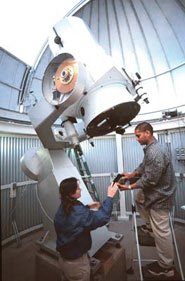 Aquired on 9 August 2007, the MCCM Observatory is built around our Optical Guidance Systems (OGS) RC24, a modern 24 inch (0.61 m) aperture Ritchey-Chrétien professional-grade computer controlled telescope complete with Fork Mount, a 5 meter diameter observatory dome with welded steel base structure. We obtained the complete design blueprints for the entire facility as it was built for Biosphere 2 near Tucson, Arizona and this includes the plans for the observatory with a detached classroom and control facility building, so the reconstruction of this in Maryland should proceed uneventfully.
Aquired on 9 August 2007, the MCCM Observatory is built around our Optical Guidance Systems (OGS) RC24, a modern 24 inch (0.61 m) aperture Ritchey-Chrétien professional-grade computer controlled telescope complete with Fork Mount, a 5 meter diameter observatory dome with welded steel base structure. We obtained the complete design blueprints for the entire facility as it was built for Biosphere 2 near Tucson, Arizona and this includes the plans for the observatory with a detached classroom and control facility building, so the reconstruction of this in Maryland should proceed uneventfully.

